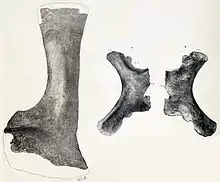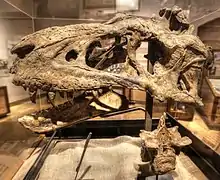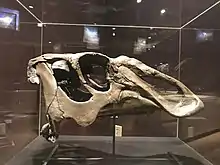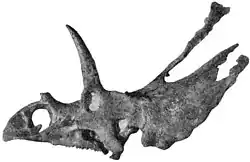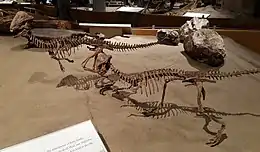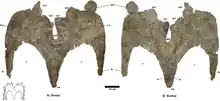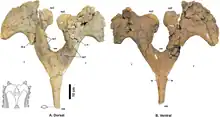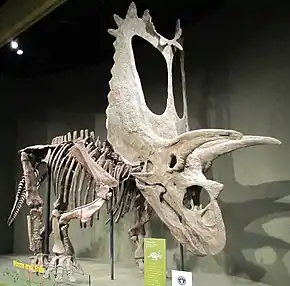Kirtland Formation
The Kirtland Formation (originally the Kirtland Shale) is a sedimentary geological formation.[1]
| Kirtland Formation | |
|---|---|
| Stratigraphic range: Campanian (typically Kirtlandian) | |
 Kirtland Formation at its type location south of Kirtland, New Mexico | |
| Type | Geological formation |
| Sub-units | Hunter Wash, Farmington and De-na-zin Members |
| Underlies | Ojo Alamo Formation |
| Overlies | Fruitland Formation |
| Thickness | 594 m (1,949 ft) |
| Lithology | |
| Primary | Sandstone |
| Other | Shale, mudstone, conglomerate |
| Location | |
| Coordinates | 36.708°N 108.350°W |
| Approximate paleocoordinates | 42.6°N 76.3°W |
| Region | |
| Country | |
| Extent | San Juan Basin |
| Type section | |
| Named for | Kirtland Post Office |
| Named by | C.M. Bauer |
| Year defined | 1916 |
 Kirtland Formation (the United States)  Kirtland Formation (New Mexico) | |

Description
The Kirtland Formation is the product of alluvial muds and overbank sand deposits from the many channels draining the coastal plain that existed on the inland seashore of North America, in the late Cretaceous period. It overlies the Fruitland Formation. It is found in the San Juan Basin in the states of New Mexico and Colorado, in the United States of America.
The base of the Kirtland Formation and its lowest sub-unit, the Hunter Wash member, has been dated to 75.02 ± 0.13 Ma.[2] Together with the upper part of the underlying Fruitland Formation, this contains fossils representing the Hunter Wash local fauna. The border between the Hunter Wash member and overlying Farmington member dates to approximately 74 million years ago. The top of the Farmington member and bottom of the overlying De-na-zin member has been radiometrically dated to 73.83 ± 0.18 Ma ago. The top of the De-na-zin member, which contains the Willow Wash local fauna, has been dated to 73.49 ± 0.25 Ma ago.[1]
Overlying the De-na-zin member is a unit called the Naashoibito member This has often been considered to be part of the Kirtland formation, but more recently has been transferred back to the overlying Ojo Alamo Formation, which it had originally been part of.[1]
History of investigation
The formation was named by C.M. Bauer in 1916 for exposures near the Kirtland Post Office.[3]
Stratigraphy

Vertebrate paleofauna
Saurischians
| Saurischians of the Kirtland Formation | ||||||
|---|---|---|---|---|---|---|
| Genus | Species | Member | Material | Notes | Images | |
|
A. sanjuanensis[4] |
Specimens actually from the Naashoibito member of the Ojo Alamo Formation[5] |
| ||||
|
A. mirandus[6] |
|
Remains are now referred to Bistahieversor, although these remains may possibly have come from the Fruitland Formation.[7] | ||||
| Bistahieversor[8] | B. sealeyi[8] |
|
An articulated skull and undescribed postcranial skeleton of an adult individual, and an incomplete skull and postcranial skeleton of a juvenile individual.[8] | A eutyrannosaur tyrannosauroid also known from the Fruitland Formation.[8] | ||
|
Indeterminate[6] |
|
Remains are now referred to Bistahieversor, although these remains may possibly have come from the Fruitland Formation.[7] | ||||
| Dromaeosauridae[9] | Indeterminate[9] | Numerous isolated teeth.[9] | Indeterminate dromaeosaurid remains.[9] | |||
| Ornithomimidae[9] | Indeterminate[9] |
|
A distal end of a phalanx, and [two] partial manual unguals.[9] | Indeterminate ornithomimid remains.[9] | ||
| Saurornitholestes[10] | S. sullivani[10] |
|
A nearly complete frontal.[10] | A saurornitholestine dromaeosaurid, sister taxa to Saurornitholestes langstoni.[10] | ||
| "Saurornitholestes" | "S." robustus[11] |
|
A nearly complete frontal.[11] | Originally assigned to Saurornitholestes, actually a troodontid.[12] | ||
| cf. Struthiomimus[9] | cf. S. altus[9] | A centrum of a dorsal vertebra, distal portion of a metatarsal, and proximal phalanx.[9] | Indeterminate remains that may belong to Struthiomimus altus.[9] | |||
| Tyrannosauridae[9] | Indeterminate[9] | A partial skeleton, dentary, metatarsal, and numerous teeth.[9] | Indeterminate tyrannosaurid material.[9] | |||
Ornithischians
| Ornithischians reported from the Kirtland Formation | ||||||
|---|---|---|---|---|---|---|
| Genus | Species | Member | Material | Notes | Images | |
| A. minor[13] |
|
A partial girdle, scapulocoracoids, humerus, proximal portion of the radius, cervical and/or dorsal vertebrae, complete and fragmentary thoracic osteoderms, and other unidentifiable postcranial fragments.[13] | An ankylosaurine ankylosaurid part of the Hunter Wash Member.[13] |
 Nodocephalosaurus (right) | ||
| A. horneri[14] |
|
An incomplete skull consisting of premaxillae, nasals, maxilla, lacrimal, jugal, prefrontal, postorbital, squamosal, frontal, parietal, and fragment of dentary with teeth.[14] | A kritosaurin hadrosaurid from the De-Na-Zin Member.[14] | |||
| Bisticeratops[15] | B. froeseorum[15] |
|
A nearly complete skull.[15] | A chasmosaurine ceratopsid, originally identified as a specimen of Pentaceratops.[15] | ||
| Kritosaurus[14] | K. navajovius[14] |
|
[Two] incomplete skulls, an atlas, axis and cervical vertebrae.[14] | A kritosaurin hadrosaurid also known from the Cerro del Pueblo Formation of Mexico.[14] | ||
| Naashoibitosaurus[14] | N.ostromi[14] |
|
A skull lacking the premaxillae and mandible, a partial humerus, cervical vertebrae and dorsal vertebrae.[14] | A kritosaurin hadrosaurid, distinct from Kritosaurus.[14] | ||
| Nodocephalosaurus[16] | N. kirtlandensis[16] |
|
A partial skull.[16] | An ankylosaurine ankylosaurid that has cranial ornamentation similar to Akainacephalus, an ankylosaur from the Kaiparowits Formation.[16][17] | ||
| Parasaurolophus[18] | P. tubicen[18] |
|
[Two] incomplete and fragmentary skulls.[18] | A lambeosaurine hadrosaurid known from partial cranial remains.[18] | ||
| P. fenestratus[19] |
|
A crushed but nearly complete skull, mandible, cervical vertebrae, dorsal vertebrae, sacral vertebrae, caudal vertebrae, chevrons, scapulae, coracoids, radii, ulnae, ischia, ilia, pubes, femora, tibiae, astragali, manual phalanxes and manual unguals.[20] | A junior synonym of Pentaceratops sternbergii, diagnostic characteristics of the species were pathologies. | |||
|
P. sternbergi[19] |
|
A crushed but nearly complete skull, mandible, cervical vertebrae, dorsal vertebrae, sacral vertebrae, caudal vertebrae, chevrons, scapulae, coracoids, radii, ulnae, ischia, ilia, pubes, femora, tibiae, astragali, manual phalanxes and manual unguals.[20] | A chasmosaurine ceratopsid also known from the Fruitland Formation.[20] | |||
| Sphaerotholus[22] | S. goodwini[22] |
|
A partial skull lacking the facial and palatal elements.[22] | A pachycephalosaurine pachycephalosaurid also known from the Hell Creek and Horseshoe Canyon Formation.[22] | ||
| Stegoceras[23] | S. novomexicanum[23] |
|
An incomplete parietal.[23] | A basal pachycephalosaurid also known from the upper Fruitland Formation.[23] | ||
| Terminocavus[24] | T. sealeyi[24] |
|
A parietal, partial squamosal, jugal, epijugal, partial quadratojugal, partial sacrum and vertebral fragments.[24] | A chasmosaurine ceratopsid that has been hypothesized to form an anagenetic series with several other chasmosaur species, including Navajoceratops.[24] | ||
| Navajoceratops[24] | N. sullivani[24] |
|
A parietal, squamosal fragments, fused jugal\epijugal and other unidentified cranial fragments.[24] | A chasmosaurine ceratopsid that has been hypothesized to form an anagenetic series with several other chasmosaur species, including Terminocavus.[24] | ||
| Titanoceratops[25] | T. ouranos[25] | A partial skull, syncervical vertebrae, cervical vertebrae, dorsal vertebrae, sacral vertebrae, caudal vertebrae, ribs, humeri, radius, femora, tibiae, fibula, ilia, ischia, and ossified tendons.[25] | Possibly represents a junior synonym of Pentaceratops, holotype may possibly have come from the Fruitland Formation.[25] | |||
| Z. sanjuanensis | A complete skull, [two] first cervical half-rings, fragmentary second cervical half ring, and numerous fragmentary osteoderms.[26] | An ankylosaurine ankylosaurid closely related to Scolosaurus. | ||||
Pterosaurs
| Pterosaurs of the Kirtland Formation | ||||||
|---|---|---|---|---|---|---|
| Genus | Species | Location | Member | Abundance | Notes | Images |
|
N. boerei[27] |
|
Partial phalanx and ulna fragment[27] |
A possible azhdarchid pterosaur known from fragmentary remains.[27] |
|||
Crurotarsans
| Crurotarsans of the Kirtland Formation[20] | ||||||
|---|---|---|---|---|---|---|
| Genus | Species | Location | Member | Abundance | Notes | Images |
|
B. montana |
|
Member of the Willow Wash local fauna. |
| |||
|
D. kirtlandicus |
|
Member of the Willow Wash local fauna. |
||||
|
Indeterminate[28] |
|
Member of the Willow Wash local fauna. |
||||
Turtles
| Turtles of the Kirtland Formation[20] | ||||||
|---|---|---|---|---|---|---|
| Genus | Species | Location | Member | Abundance | Notes | Images |
|
B. nobilis |
|
Member of the Willow Wash local fauna. |
||||
|
D. nodosa |
|
Member of the Willow Wash local fauna. |
||||
|
N. baueri |
|
Member of the Willow Wash local fauna. |
||||
|
Plastomenus |
P. robustus |
|
Member of the Willow Wash local fauna. |
|||
|
Thescelus |
T. hemispherica |
|
Member of the Willow Wash local fauna. |
|||
Bony fish
| Bony fishes of the Kirtland Formation[20] | ||||||
|---|---|---|---|---|---|---|
| Genus | Species | Location | Member | Abundance | Notes | |
|
M. chauliodous |
|
Member of the Willow Wash local fauna. | ||||
Cartilaginous fish
| Cartilaginous fish of the Kirtland Formation[20] | ||||||
|---|---|---|---|---|---|---|
| Genus | Species | Location | Member | Abundance | Notes | |
|
M. bipartitus |
|
Member of the Willow Wash local fauna. | ||||
Color key
|
Notes Uncertain or tentative taxa are in small text; |
References
- Sullivan & Lucas 2006.
- Fowler 2017.
- Bauer 1916.
- Weishampel, Dodson & Osmólska 2004, pp. 580–581, 3.3 New Mexico, United States; 10. Lower Kirtland Formation and 11. Upper Kirtland Formation.
- Jasinski & Sullivan 2011.
- Carr & Williamson 2010, p. 1, Systematic Paleontology.
- Carr & Williamson 2010, p. 1, Systematic Paleontology; Referred Specimens.
- Carr & Williamson 2010, p. 1, Systematic Paleontology; Holotype.
- Lucas, Spencer G.; Mateer, Niall J.; Hunt, Adrian P.; O'Neill, F. Michael (1987). Dinosaurs, the age of the Fruitland and Kirtland Formations, and the Cretaceous-Tertiary boundary in the San Juan Basin, New Mexico.
- Jasinski 2016.
- Sullivan 2006, p. 253, Abstract.
- Evans et al. 2014.
- Burns & Sullivan 2011.
- Prieto-Márquez, A. (2013). "Skeletal morphology of Kritosaurus navajovius (Dinosauria:Hadrosauridae) from the Late Cretaceous of the North American south-west, with an evaluation of the phylogenetic systematics and biogeography of Kritosaurini". Journal of Systematic Palaeontology. 12 (2): 133–175. doi:10.1080/14772019.2013.770417. S2CID 84942579.
- Dalman SG, Jasinski SE, Lucas SG (2022). "A new chasmosaurine ceratopsid from the Upper Cretaceous (Campanian) Farmington Member of the Kirtland Formation, New Mexico". New Mexico Museum of Natural History and Science Bulletin. 90: 127–153.
- Sullivan, R. (1999). "Nodocephalosaurus kirtlandensis, gen et sp nov., a new ankylosaurid dinosaur (Ornithischia; Ankylosauria) from the Upper Cretaceous Kirtland Formation (Upper Campanian), San Juan Basin, New Mexico". Journal of Vertebrate Paleontology. 19 (1): 126–139. Bibcode:1999JVPal..19..126S. doi:10.1080/02724634.1999.10011128.
- Jelle P. Wiersma; Randall B. Irmis (2018). "A new southern Laramidian ankylosaurid, Akainacephalus johnsoni gen. et sp. nov., from the upper Campanian Kaiparowits Formation of southern Utah, USA". PeerJ. 6: e5016. doi:10.7717/peerj.5016. PMC 6063217. PMID 30065856.
- Sullivan & Williamson 1999.
- Weishampel, Dodson & Osmólska 2004, p. 580, 3.3 New Mexico, United States; 10. Lower Kirtland Formation.
- Sullivan & Lucas 2006, p. 11, Table 1.
- Sullivan & Lucas 2006, p. 10, Kirtlandian Index Fossils.
- Williamson Thomas E.; Carr Thomas D. (2002). "A new genus of highly derived pachycephalosaurian from western North America". Journal of Vertebrate Paleontology. 22 (4): 779–801. doi:10.1671/0272-4634(2002)022[0779:angodp]2.0.co;2. S2CID 86112901.
- Steven E. Jasinski; Robert M. Sullivan (2011). "Re-evaluation of pachycephalosaurids from the Fruitland-Kirtland transition (Kirtlandian, late Campanian), San Juan Basin, New Mexico, with a description of a new species of Stegoceras and a reassessment of Texascephale langstoni" (PDF). Fossil Record 3. New Mexico Museum of Natural History and Science, Bulletin. 53: 202–215.
- Fowler, D.W.; Freedman Fowler, E.A. (2020). "Transitional evolutionary forms in chasmosaurine ceratopsid dinosaurs: evidence from the Campanian of New Mexico". PeerJ. 8: e9251. doi:10.7717/peerj.9251. PMC 7278894. PMID 32547873.
- Longrich, N.R. (2011). "Titanoceratops ouranos, a giant horned dinosaur from the Late Campanian of New Mexico". Cretaceous Research. 32 (3): 264–276. Bibcode:2011CrRes..32..264L. doi:10.1016/j.cretres.2010.12.007.
- Arbour et al. 2014.
- Sullivan & Fowler 2011.
- Listed as "cf. Leidyosuchus sp."
Bibliography
- Arbour, Victoria M.; Burns, Michael E.; Sullivan, Robert M.; Lucas, Spencer G.; Cantrell, Amanda K.; Fry, Joshua; Suazo, Thomas L. (24 September 2014). "A New Ankylosaurid Dinosaur from the Upper Cretaceous (Kirtlandian) of New Mexico with Implications for Ankylosaurid Diversity in the Upper Cretaceous of Western North America". PLOS ONE. 9 (9): e108804. Bibcode:2014PLoSO...9j8804A. doi:10.1371/journal.pone.0108804. PMC 4177562. PMID 25250819.
- Bauer, C. M. (1916). "Stratigraphy of a part of the Chaco River Valley". U.S. Geol. Survey Prof. Paper. 98-P. doi:10.3133/pp98P.
- Burns, Michael E. (2008). "Taxonomic utility of ankylosaur (Dinosauria, Ornithischia) osteoderms: Glyptodontopelta mimus Ford, 2000: a test case". Journal of Vertebrate Paleontology. 28 (4): 1102–1109. Bibcode:2008JVPal..28.1102B. doi:10.1671/0272-4634-28.4.1102. S2CID 140672072.
- Burns, Michael E.; Sullivan, Robert M. (2011). "A new ankylosaurid from the Upper Cretaceous Kirtland Formation, San Juan Basin, with comments on the diversity of ankylosaurids in New Mexico" (PDF). Fossil Record 3. New Mexico Museum of Natural History and Science, Bulletin. 53: 169–178.
- Carr, T.D.; Williamson, T.E. (2010). "Bistahieversor sealeyi, gen. et sp. nov., a new tyrannosauroid from New Mexico and the origin of deep snouts in Tyrannosauroidea". Journal of Vertebrate Paleontology. 30 (1): 1–16. Bibcode:2010JVPal..30....1C. doi:10.1080/02724630903413032. S2CID 54029279.
- Evans, David C.; Larson, Derek W.; Cullen, Thomas M.; Sullivan, Robert M.; Sues, Hans-Dieter (2014). ""Saurornitholestes" robustus is a troodontid (Dinosauria: Theropoda)". Canadian Journal of Earth Sciences. 51 (7): 730–734. Bibcode:2014CaJES..51..730E. doi:10.1139/cjes-2014-0073.
- Fowler, Denver Warwick (22 November 2017). "Revised geochronology, correlation, and dinosaur stratigraphic ranges of the Santonian-Maastrichtian (Late Cretaceous) formations of the Western Interior of North America". PLOS ONE. 12 (11): e0188426. Bibcode:2017PLoSO..1288426F. doi:10.1371/journal.pone.0188426. PMC 5699823. PMID 29166406.
- Jasinski, Steven (2016). "A new dromaeosaurid (Theropoda: Dromaeosauridae) from the Late Cretaceous of New Mexico (B&W)". New Mexico Museum of Natural History and Science Bulletin. 67: 79–88.
- Jasinski, Steven E.; Sullivan, Robert M. (2011). "Re-evaluation of pachycephalosaurids from the Fruitland-Kirtland transition (Kirtlandian, late Campanian), San Juan Basin, New Mexico, with a description of a new species of Stegoceras and a reassessment of Texascephale langstoni" (PDF). Fossil Record 3. New Mexico Museum of Natural History and Science, Bulletin. 53: 202–215.
- Jasinski, S. E.; Sullivan, R. M.; Lucas, S. G. (2011). "Taxonomic composition of the Alamo Wash local fauna from the Upper Cretaceous Ojo Alamo Formation (Naashoibito Member) San Juan Basin, New Mexico". New Mexico Museum of Natural History and Science Bulletin. 53: 216–271. Retrieved 11 September 2020.
- Sullivan, R.M. (2006). "Saurornitholestes robustus, n. sp. (Theropoda:Dromaeosauridae) from the Upper Cretaceous Kirtland Formation (De-Na-Zin member_), San Juan Basin, New Mexico" (PDF). NMMNH Bulletin. 35: 253–256.
- Sullivan, Robert M.; Fowler, Denver W. (2011). "Navajodactylus boerei, n. gen., n. sp., (Pterosauria, ?Azhdarchidae) from the Upper Cretaceous Kirtland Formation (upper Campanian) of New Mexico" (PDF). Fossil Record 3. New Mexico Museum of Natural History and Science, Bulletin. 53: 393–404.
- Sullivan, R.M.; Lucas, S.G. (2006). "The Kirtlandian land-vertebrate "age" – faunal composition, temporal position and biostratigraphic correlation in the nonmarine Upper Cretaceous of western North America". New Mexico Museum of Natural History and Science Bulletin. 35: 7–29. Retrieved 14 September 2021.
- Sullivan, R.M.; Lucas, S.G. (2015). "Cretaceous Vertebrates of New Mexico". New Mexico Museum of Natural History and Science Bulletin. 68: 97–129.
- Sullivan, R.S.; Williamson, T.E. (1999). "A new skull of Parasaurolophus (Dinosauria: Hadrosauridae) from the Kirtland Formation of New Mexico and a revision of the genus" (PDF). New Mexico Museum of Natural History and Science Bulletin. 15: 1–52.
- Weishampel, David B.; Dodson, Peter; Osmólska, Halszka, eds. (2004). The Dinosauria (2nd ed.). Berkeley: University of California Press. ISBN 0-520-24209-2.
